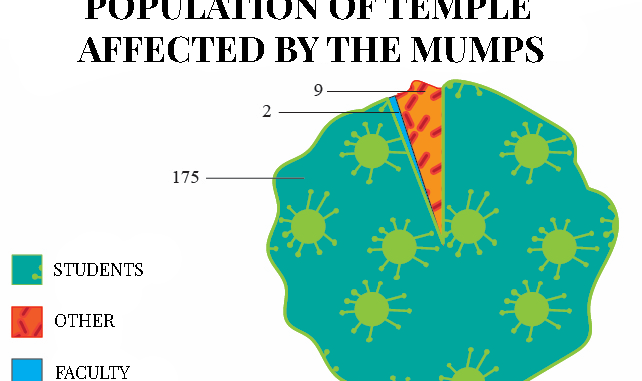
Dominic Martinelli said he had one of the worst cases of the mumps during Temple’s outbreak earlier this year.
Martinelli, a junior tourism and hospitality management major, is allergic to the mumps, measles and rubella vaccine. Student Health Services closely monitored his symptoms that continued into the summer.
He was among the 186 people infected with the mumps during an outbreak in March at Main Campus that prompted the university to change its vaccination policies for incoming students.
Several months after the start of the outbreak, local health officials are still tallying up the cost of containing the disease, while investigations into how it spread remain ongoing.
Newly enrolled students starting classes this week were required to show proof of two MMR vaccines, said Mark Denys, director of SHS. The rules closely resemble Pennsylvania’s religious, philosophical or medical exemption law.
Temple will be stricter in requiring students to produce documentation for vaccines against diseases like chickenpox and meningitis as well, Denys added.
“Do I think that’s going to prevent anything? No, I think very few people will get vaccinated based on that,” Denys said. “But we’re going to have more information at our fingertips.”
Sharing items, like food, cups or cigarettes, was a large factor contributing to the spread of the disease, Denys said.
“They put people at risk and just by being in a party environment in the basement of a house, where you’re back to back with people — that’s an environment where things can spread rapidly,” he added.
In addition, several of those who had received the MMR vaccine contracted the mumps as the shot is known to be only 88 percent effective in preventing mumps at two doses and 78 percent effective at one dose, Denys said.
“If the success rate was higher, then this would not have been an issue to begin with,” he said.
The final count of those infected included 175 students, two staff members and nine others not affiliated with Temple, Denys said.
Patient zero was a student who acquired the infection outside of the country, said Dana Perella, the manager of the acute communicable disease program at the Philadelphia Department of Health.
While there are no reported cases of students contracting mumps during the summer, students should continue to practice good hand hygiene and respiratory etiquette, Perella added.
“A good lesson learned is keeping an eye out for travel-associated illnesses, especially at the start of the semester,” Perella said. “There’s also the distinct possibility that individuals can be infected from different sources. The virus is circulating abroad.”
Students, including those who had already had the second MMR shot, were encouraged to receive another dose of the MMR vaccine in March. Temple Student and Employee Health Services, in conjunction with the Philadelphia Department of Public Health, administered close to 5,000 mumps vaccines at the two walk-in clinics.
Though the total cost of containing the outbreak is still being calculated, Denys said that the sum represented a significant investment from the university.
Experts are still investigating how the epidemic spread so widely given that some of the victims had already been vaccinated, Denys and Parella said.
“We will be better prepared and have more information to be able to communicate more effectively with people,” Denys added.


Be the first to comment